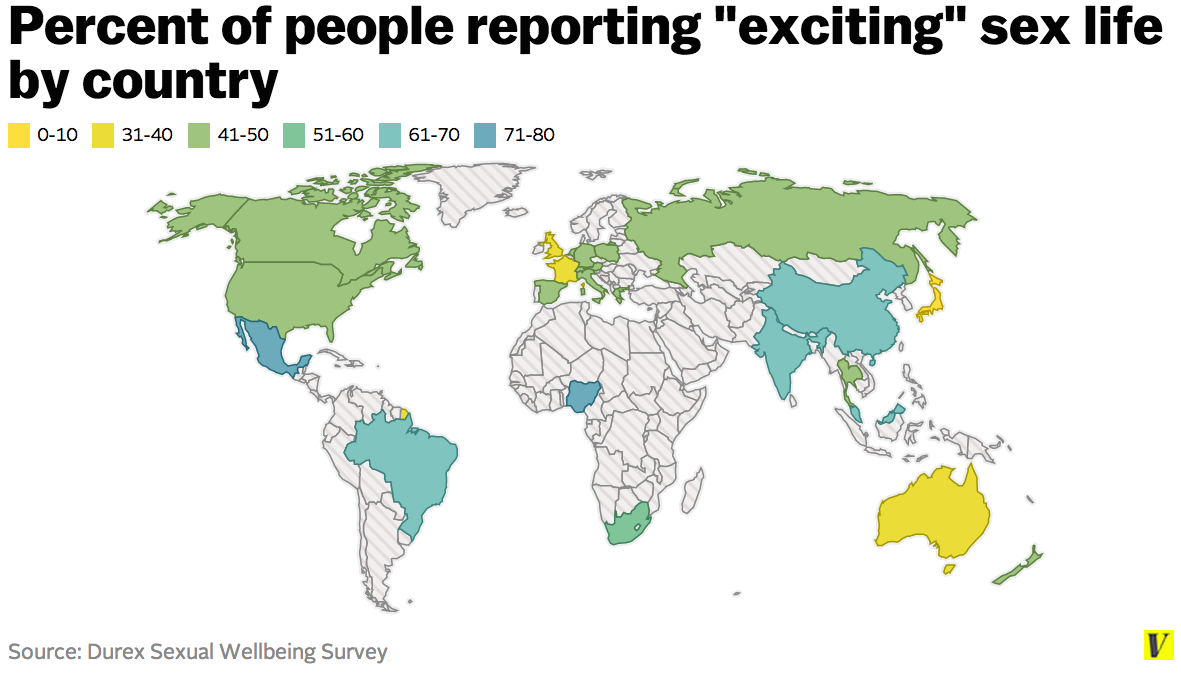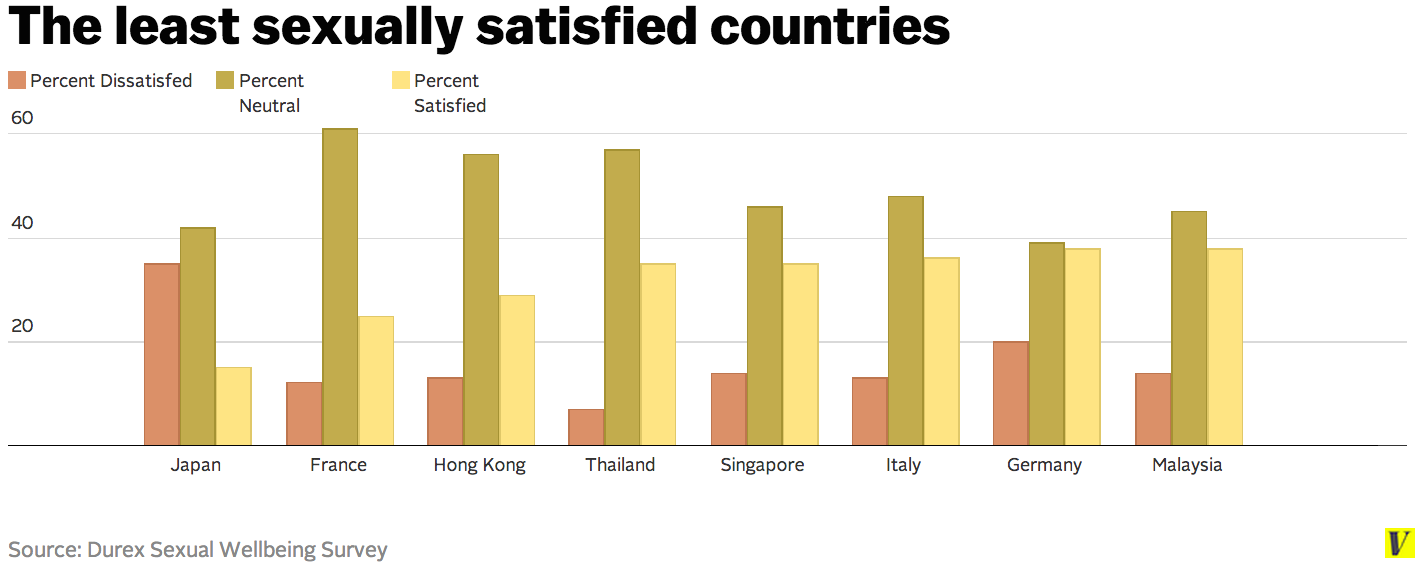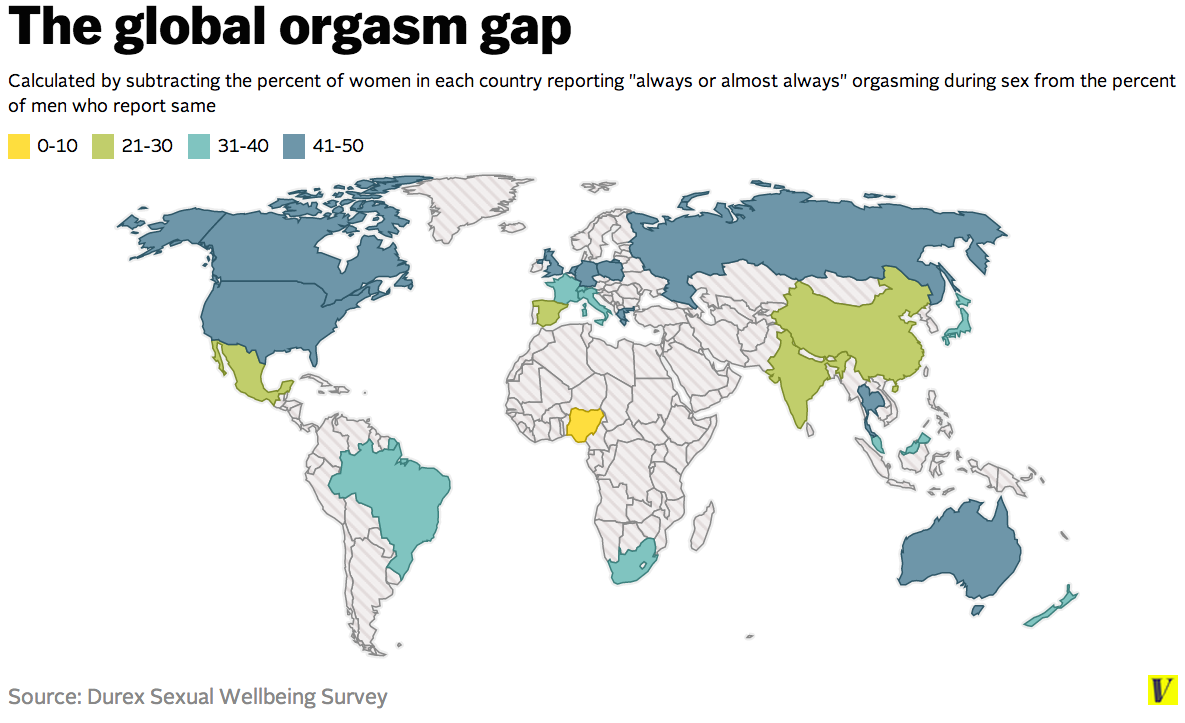
Where people have the best sex, the worst sex, and the most STIs
People around the world are having sex. Right now. These maps and charts tell you how they’re doing it.
The data comes from two surveys done by Durex, the condom folks. Their Sexual Wellbeing Survey (from 2007/2008) and Face of Global Sex (2012) are methodologically rigorous. A polling firm, Harris Interactive, set up large sample size online polls designed to capture a representative sample of heterosexual sex-havers from a number of countries around the world.
For reports designed principally with Durex’s corporate interests in mind, they’re pretty well done. The data also reveals a lot of interesting things about how much people in different countries enjoy sex, when they tend to do it, and gender equality (or the lack thereof) in sexual enjoyment. Here’s what we learned.
 1. People have more exciting sex in Nigeria and Mexico
1. People have more exciting sex in Nigeria and Mexico
There are a few surprises on the global excitement map. For instance, the French don’t live up to their reputation as great lovers, reporting some of the lowest levels of sexual excitement in the survey. Mexico and Nigeria beat almost everywhere else by a hefty margin.
One item of note: the Nigerian interviews were done in person, not online like the rest of the surveys. That may introduce some bias in the result: imagine how much harder it would be to tell a live person rather than a computer that your sex life is kinda meh.
But what’s up with Mexico? Well, one thing that Durex found is that people tend to be much happier with their sex lives when they feel respected during the act. And Mexicans feel more respected than anyone else in the world:

Respect during sex doesn’t fully explain excitement on its own, or else Spain would would be a whole lot more excited. But it makes sense that it explains part of what makes a country more excited about sex. Spain, for instance, might have lower levels of sexual excitement, somewhere down near France or Britain’s level, if it weren’t so damn self-respecting. Mexico’s super-high respect rate may explain its edge over some other highly excited countries.
Finally, Japan’s results are very sad. Only 10 percent of Japanese people report exciting sex. That’s less than a third of the next-lowest, Hong Kong’s, at 32. Which, unsurprisingly, leads to…
2. People in Japan are really unhappy with their sex lives
Even among the worst performers in Durex’s surveys, Japan stands out. The below chart shows the 6 countries in the world where less than 40 percent of people report being “very or fully satisfied” with their sex lives. Note the difference between Japan’s pink/yellow bars and everyone else’s:

See that? Japan is the only country in the world where a higher percentage of people report being dissatisfied with their sex lives than satisfied.
The simplest explanation for Japan’s sexual woes is that they’re just not doing it. Thirty-four percent of Japanese folk report having sex weekly. The next lowest country, somewhat surprisingly the United States, reports a weekly 53 percent sex rate (though, this isn’t the only indication of sexual satisfaction: 76 percent of Italians are having sex weekly, and they’re still near the bottom of the satisfaction pack).
It’s not surprising that the Japanese are having infrequent, unsatisfying sex. For years, Japan reported some of the longest average working hours in the world. In and of itself, this makes sex less likely. Veteran Japan reporter Michael Zielenziger says working hours have made “physical contact” between spouses “so infrequent that some of Japan’s leading homebuilders now report that more than one in three custom homes is built with separate bedrooms for husband and wife.”

Barcroft Media/Getty Images
It gets worse. Japanese cultural and business norms strongly discourage women from marrying if they’d like to succeed at work, so marriage is on the decline. And married people, according to science, have the most sex around the world.
While Japanese people are working less hours today (down to merely American-level of hours worked per week), its economy has slowed considerably and employment has gotten worse. Both slow growth and unemployment contribute to stress, which Durex found to be one of the biggest contributors to an unpleasant sex life.
Japan’s economy is something of a perfect storm of sexlessness. It makes Japanese people overworked, underemployed, and undermarried.
3. The orgasm gap between genders varies by country
Around 48 percent of people worldwide “always” or “almost always” orgasm. Unsurprisingly, the figure for men (61 percent) is 28 points higher than the equivalent for women (33 percent).
What is interesting is how that gap varies by country. Check out this map plotting male orgasm rates minus female orgasm rates around the world.

Nigeria has an implausibly small four point gap, suggesting once again that the in-person interviews are skewing the numbers. Exempting that, Singapore, China, and Mexico had the smallest differences between between male and female orgasm rates, while Russia and Thailand had the largest.
The thing that’s most surprising about this is there’s virtually no correlation between a country’s overall level of gender equality and its orgasm gap. Some comparatively egalitarian countries, like Spain, score fairly well, while others, like the US and Canada, score poorly. Likewise, some nations with obviously larger gender inequalities in terms of social status and employment, like India, do better, while Thailand does poorly.
What this suggests, then, is that improvements in women’s standings around society do not always translate to improvements in sexual partnerships. Making sex more equitable in at least one important way — putting the female orgasm on the same pedestal as the its male equivalent — is a problem that even more developed countries haven’t solved.
4. Turkey has an alarmingly high STI rate
Sexually transmitted infections are not fun. And in most places, people either don’t seem to have them or won’t tell pollsters they have them. Except for Turkey:

This map actually understates Turkey’s personal problems. 55 percent of Turks reported never having an STI; the next worst country, Russia, is a full 12 points higher.
Again, it could be that there’s something wrong with the data. Perhaps Turks are more honest or more paranoid than everyone else. But Durex data from 2007, five years before the recent Global Face report, suggests another explanation. Turks reported more sex partners than any other country in the world, and were doing it unprotected about 45 percent of the time:

Times Online
Though Turkey’s STI rates weren’t that high in 2007, people having unprotected sex with a lot of partners for a few years could certainly raise them by 2012.
5. People in Asia tend to be pretty old when they lose their virginity, by global standards
Switching gears from too much sex to not having it, it looks like people lose their virginity at different ages in different places. Asian countries have a much higher mean age of virginity loss than nations basically everywhere else.

Keep in mind that both the African and South American data covers only two countries in each rather large continents. So, if you compare Asia with the other more continents that are more comprehensively covered, the difference becomes even more stark.
This isn’t just a one-off finding. A study published by World Health Organization and the prestigious Lancet medical journal confirmed that Asian countries tended to have higher median ages of virginity loss than the global average.
There seem to be several reasons for this, and they vary country to country and region by region. In South Asia, the Lancet researchers found that men lost their virginity at extremely old ages, and women at relatively young ones — leading to an above-average cross-gender average. That’s because, in South Asian countries, many girls are married to older men at young ages.
The reason for similar numbers in East Asia are harder to pin down. I don’t normally like to use “culture” as an explanation for things, but some research suggests there may be something about East Asian religious traditions or cultural norms that promotes sexual conservatism. One study by a group of researchers found very high levels of reported “embarrassment” about discussing sexual practices in public. These results, according to the researchers is that “in comparison with men and women from ‘Western’ regions,” respondents living in East Asian countries were “more sexually conservative, more male-orientated and less sexually active.”
6. The French and Indians have short sex, while Nigerians and Greeks take their time
Once people start having sex, they do it pretty differently. Some countries prefer quickies, while others are a touch more languid.

By this count, the average Nigerian couple spends almost twice as long per session than the average Indian pair (24 v. 13.2). Why?
Couldn’t tell you, but it sure is curious.
Posted on: Vox












